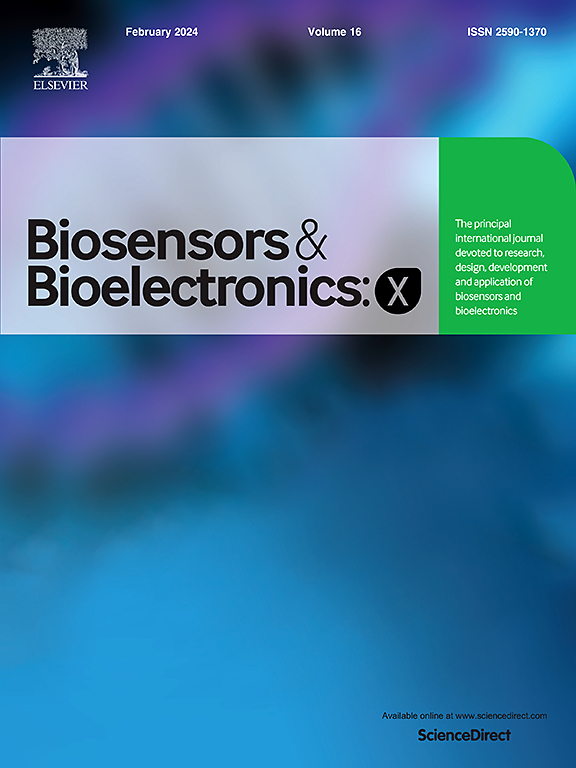Enhanced glucose sensing via nanoparticles-modified extended gates: A novel approach to electric double layer modulation and signal amplification in field effect transistors for improved detection sensitivity
IF 10.61
Q3 Biochemistry, Genetics and Molecular Biology
引用次数: 0
Abstract
This study presents an innovative glucose sensing platform that harnesses the enhanced electrocatalytic properties of planar electric double layer (EDL) structures in conjunction with extended gate field effect transistors (EGFETs). By integrating specific nanoparticles onto the sensor surface, this platform achieves substantial improvements in glucose detection sensitivity and overall performance. The materials employed in this research include Ni nanowires combined with graphene films, CuO nanoparticles incorporated into carbon nanostructures, and gold nanoparticles affixed to ZnO nanostructures. These nanomaterials exhibit remarkable catalytic activity, while the localized electric field effect generated by the electric double layer significantly amplifies the signal, thereby enhancing sensitivity. Experimental findings reveal notable enhancements in both sensitivity and detection limits compared to conventional glucose sensors, underscoring the potential of this platform for effective glucose monitoring. Specifically, the Ni nanowire-graphene film sensor recorded a sensitivity of 3102.7 μA mM⁻1 cm⁻2 with a detection limit of 51 nM. The CuO nanoparticle-carbon nanostructure sensor achieved a sensitivity of 2206.25 μA mM⁻1 cm⁻2 and a detection limit of 39 nM, while the gold nanoparticle-ZnO nanostructure sensor demonstrated a sensitivity of 811.8 μA mM⁻1 cm⁻2 with a detection limit of 59 nM.
通过纳米粒子修饰的扩展门增强葡萄糖传感:电场效应晶体管中双电层调制和信号放大的新方法,以提高检测灵敏度
本研究提出了一种创新的葡萄糖传感平台,该平台利用平面双电层(EDL)结构与扩展栅场效应晶体管(egfet)结合的增强电催化性能。通过将特定的纳米颗粒集成到传感器表面,该平台在葡萄糖检测灵敏度和整体性能方面取得了实质性的提高。本研究采用的材料包括结合石墨烯薄膜的Ni纳米线,结合碳纳米结构的CuO纳米粒子,以及附着在ZnO纳米结构上的金纳米粒子。这些纳米材料表现出显著的催化活性,而双电层产生的局域电场效应显著放大了信号,从而提高了灵敏度。实验结果显示,与传统的葡萄糖传感器相比,该传感器在灵敏度和检测限方面都有显著提高,强调了该平台在有效血糖监测方面的潜力。具体来说,Ni纳米线-石墨烯薄膜传感器的灵敏度为3102.7 μA mM⁻1 cm⁻2,检测限为51 nM。CuO纳米颗粒-碳纳米结构传感器的灵敏度为2206.25 μA mM - 1 cm - 2,检测限为39 nM;金纳米颗粒- zno纳米结构传感器的灵敏度为811.8 μA mM - 1 cm - 2,检测限为59 nM。
本文章由计算机程序翻译,如有差异,请以英文原文为准。
求助全文
约1分钟内获得全文
求助全文
来源期刊

Biosensors and Bioelectronics: X
Biochemistry, Genetics and Molecular Biology-Biophysics
CiteScore
4.60
自引率
0.00%
发文量
166
审稿时长
54 days
期刊介绍:
Biosensors and Bioelectronics: X, an open-access companion journal of Biosensors and Bioelectronics, boasts a 2020 Impact Factor of 10.61 (Journal Citation Reports, Clarivate Analytics 2021). Offering authors the opportunity to share their innovative work freely and globally, Biosensors and Bioelectronics: X aims to be a timely and permanent source of information. The journal publishes original research papers, review articles, communications, editorial highlights, perspectives, opinions, and commentaries at the intersection of technological advancements and high-impact applications. Manuscripts submitted to Biosensors and Bioelectronics: X are assessed based on originality and innovation in technology development or applications, aligning with the journal's goal to cater to a broad audience interested in this dynamic field.
 求助内容:
求助内容: 应助结果提醒方式:
应助结果提醒方式:


